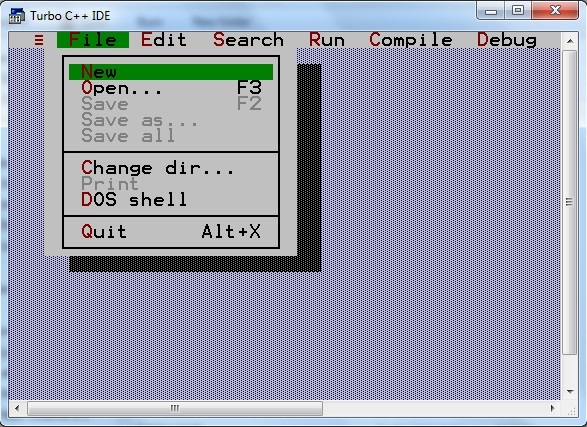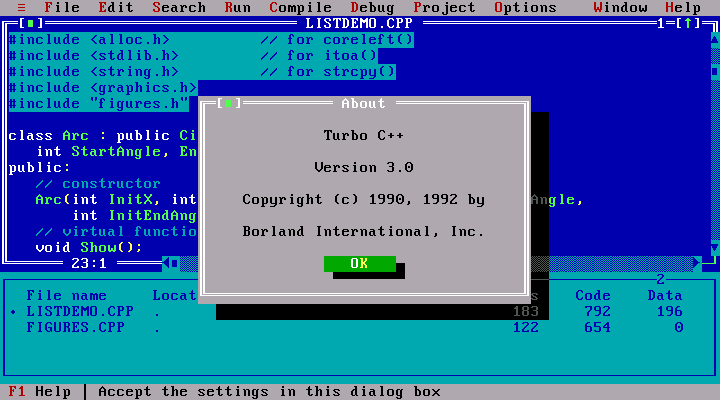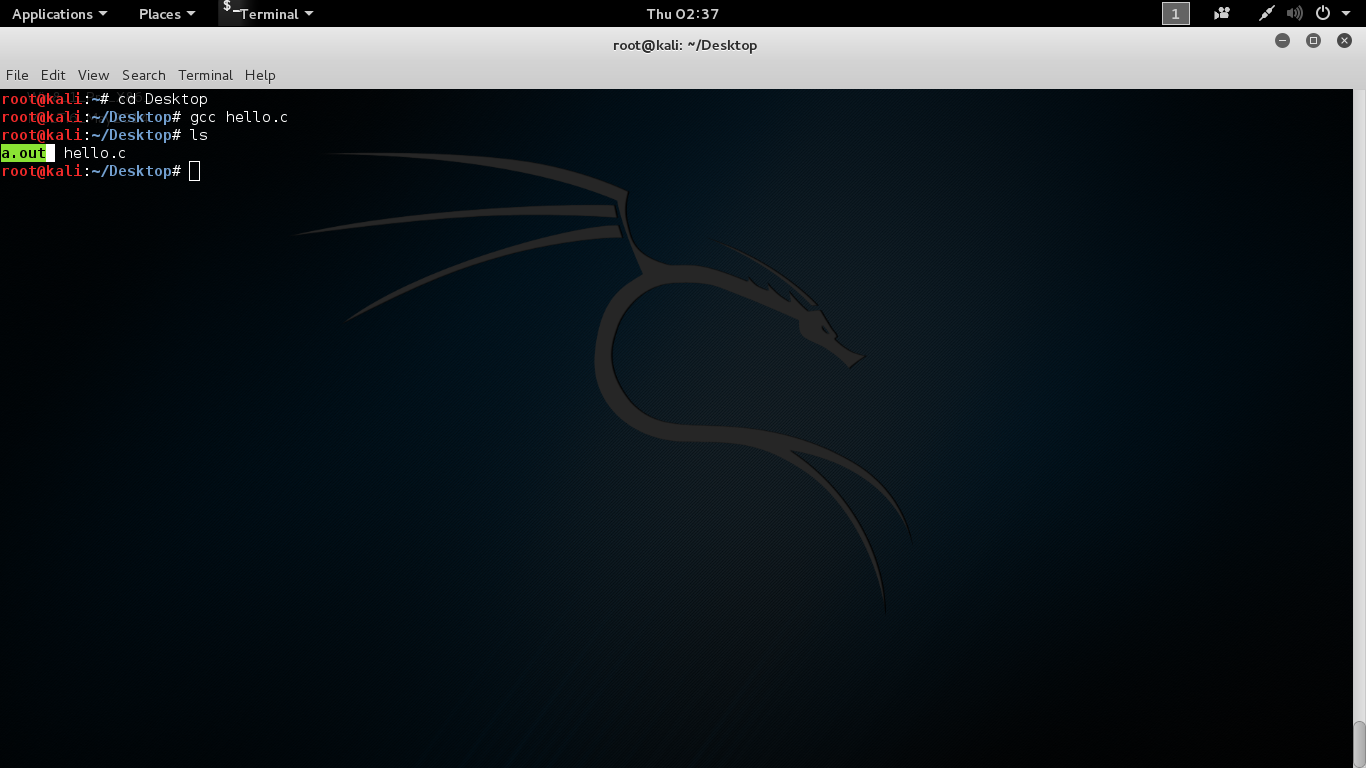Compile C Program In Dos Number
Is there any way I can compile my code for DOS! I have a simple C++ program that does not use any windows API. I can run it under windows using visual studio 2010, however, I need more speed without windows overhead. I wonder if there is any way I can compile it for running under DOS (or any real time platform) without any visual effects overhead? (It's clear I don't want to use very old compilers such as turbo c++, because I loss the optimization benefits of MSVC compiler)
FIXME: This page may have a number of dangling links, as a result of incomplete import of pages referenced from the old MinGWiki FAQ.If you find such a link, please help out, by copying and reformatting the originally referenced page content to this new wiki, to create the missing page, and link to it. C source code files are always compiled into binary code by a program called a 'compiler. There are a number of. Compiler can compile the program. Walkthrough: Compiling a Native C++ Program on the Command Line.; 9 minutes to read Contributors. In this article. Visual C++ includes a command-line C++ compiler that you can use to create everything from basic console apps to Universal Windows Platform apps, Desktop apps, device drivers, and.NET components.
Regards
3 Answers
You probably don't want to compile for DOS. DOS is a 16-bit OS, and although you can probably get GCC for DOS and use that, I promise you that it's (DOS, not GCC) so obsolete that it's probably not what you want.
If compiling for the Windows command prompt is too slow, it's probably how you've written the program itself which is the problem. You are most likely trying to solve the wrong issue. If your issue is other services on your machine taking up resources, you may want to shut them down, uninstall them, or consider using Windows Server Core as your OS, which has a minimum of services and a very thin GUI, if you could call it that at all.

DJGPP is a 32-bit gcc/g++ for DOS. It uses a DPMI host (CWSDPMI) to switch to the 32-bit protected mode. You can run the compiler either in DOS or in a VM with DOS (PC/VM+FreeDos or Dosbox). It will work in Windows 9x/2K/XP too (but generally not in Vista/7).
Open Watcom C/C++ is a 16/32-bit C/C++ compiler that can compile code for a variety of different platforms, including DOS. You can create 32-bit DPMI programs for DOS with it as well. The compiler can be run under DOS and Windows.
Similar to OW, Digital Mars is a 16/32-bit C/C++ compiler for DOS and Windows. AFAIK, the compiler can be run under Windows only.
You might also try using a compiler for Windows with WDOSX.
Did you look at G++. It's the gnu compiler, for windows.
Not the answer you're looking for? Browse other questions tagged visual-studio-2010performancereal-timedos or ask your own question.
-->Visual Studio includes a command-line C++ compiler that you can use to create everything from basic console apps to Universal Windows Platform apps, Desktop apps, device drivers, and .NET components.
In this walkthrough, you create a basic, 'Hello, World'-style C++ program by using a text editor, and then compile it on the command line. If you'd like to try the Visual Studio IDE instead of using the command line, see Walkthrough: Working with Projects and Solutions (C++) or Using the Visual Studio IDE for C++ Desktop Development.
In this walkthrough, you can use your own Visual C++ program instead of typing the one that's shown, or you can use a Visual C++ code sample from another help article.
Prerequisites
To complete this walkthrough, you must have installed either Visual Studio and the optional Desktop development with C++ workload, or the command-line Build Tools for Visual Studio.
Visual Studio is a powerful integrated development environment (IDE) that supports a full-featured editor, resource managers, debuggers, and compilers for many languages and platforms. For information on how to download and install Visual Studio, including the free Visual Studio Community edition, and to include support for C/C++ development, see Install C++ support in Visual Studio.
The Build Tools for Visual Studio installs only the command-line compilers, tools, and libraries you need to build C and C++ programs. It's perfect for build labs or classroom exercises and installs relatively quickly. To install only the command-line tools, look for Build Tools for Visual Studio on the Visual Studio Downloads page.
Before you can build a C or C++ program on the command line, you must verify that the tools are installed, and that you can access them from the command line. Visual C++ has complex requirements for the command-line environment to find the tools, headers, and libraries it uses. You can't use Visual C++ in a plain command prompt window without doing some preparation. Fortunately, Visual C++ installs shortcuts for you to launch a developer command prompt that has the environment set up for command line builds. Unfortunately, the names of the developer command prompt shortcuts and where they're located are different in almost every version of Visual C++ and on different versions of Windows. Your first walkthrough task is finding the right one to use.
Note
Xforce keygen 2016 torrent. While the quality of a render has always been related to time (the higher the quality, the longer it takes); tradition has been to control its quality and ignore the time it would take to be ready this render.
A developer command prompt shortcut automatically sets the correct paths for the compiler and tools, and for any required headers and libraries. You must set these environment values yourself if you use a regular Command Prompt window. For more information, see Set the Path and Environment Variables for Command-Line Builds. We recommend you use a developer command prompt shortcut instead of building your own.
Open a developer command prompt
If you have installed Visual Studio 2017 or later on Windows 10, open the Start menu and choose All apps. Scroll down and open the Visual Studio folder (not the Visual Studio application). Choose Developer Command Prompt for VS to open the command prompt window.
If you have installed Microsoft Visual C++ Build Tools 2015 on Windows 10, open the Start menu and choose All apps. Scroll down and open the Visual C++ Build Tools folder. Choose Visual C++ 2015 x86 Native Tools Command Prompt to open the command prompt window.
You can also use the Windows search function to search for 'developer command prompt' and choose one that matches your installed version of Visual Studio. Use the shortcut to open the command prompt window.
Next, verify that the Visual C++ developer command prompt is set up correctly. In the command prompt window, enter
cland verify that the output looks something like this:There may be differences in the current directory or version numbers, depending on the version of Visual C++ and any updates installed. If the above output is similar to what you see, then you're ready to build C or C++ programs at the command line.
Note
If you get an error such as 'cl' is not recognized as an internal or external command, operable program or batch file,' error C1034, or error LNK1104 when you run the cl command, then either you are not using a developer command prompt, or something is wrong with your installation of Visual C++. You must fix this issue before you can continue.
If you can't find the developer command prompt shortcut, or if you get an error message when you enter
cl, then your Visual C++ installation may have a problem. Try reinstalling the Visual C++ component in Visual Studio, or reinstall the Microsoft Visual C++ Build Tools. Don't go on to the next section until this works. For more information about installing and troubleshooting Visual C++, see Install Visual Studio.Note
Depending on the version of Windows on the computer and the system security configuration, you might have to right-click to open the shortcut menu for the developer command prompt shortcut and then choose Run as administrator to successfully build and run the program that you create by following this walkthrough.
Create a Visual C++ source file and compile it on the command line
In the developer command prompt window, enter
md c:helloto create a directory, and then entercd c:helloto change to that directory. This directory is where your source file and the compiled program are created in.Enter
notepad hello.cppin the command prompt window.Choose Yes when Notepad prompts you to create a file. This step opens a blank Notepad window, ready for you to enter your code in a file named hello.cpp.
In Notepad, enter the following lines of code:
This code is a simple program that will write one line of text on the screen and then exit. To minimize errors, copy this code and paste it into Notepad.
Save your work! In Notepad, on the File menu, choose Save.
Congratulations, you've created a C++ source file, hello.cpp, that is ready to compile.
Switch back to the developer command prompt window. Enter
dirat the command prompt to list the contents of the c:hello directory. You should see the source file hello.cpp in the directory listing, which looks something like:The dates and other details will differ on your computer. If you don't see your source code file, hello.cpp, make sure you've changed to the c:hello directory you created, and in Notepad, make sure that you saved your source file in this directory. Also make sure that you saved the source code with a .cpp file name extension, not a .txt extension.
At the developer command prompt, enter
cl /EHsc hello.cppto compile your program.The cl.exe compiler generates an .obj file that contains the compiled code, and then runs the linker to create an executable program named hello.exe. This name appears in the lines of output information that the compiler displays. The output of the compiler should look something like:
Note
If you get an error such as 'cl' is not recognized as an internal or external command, operable program or batch file,' error C1034, or error LNK1104, your developer command prompt is not set up correctly. For information on how to fix this issue, go back to the Open a developer command prompt section.
Note
If you get a different compiler or linker error or warning, review your source code to correct any errors, then save it and run the compiler again. For information about specific errors, use the search box on this MSDN page to look for the error number.
To run the hello.exe program, at the command prompt, enter
hello.The program displays this text and exits:
Congratulations, you've compiled and run a C++ program by using the command-line tools.
Next steps
This 'Hello, World' example is about as simple as a C++ program can get. Real world programs have header files and more source files, link in libraries, and do useful work.
You can use the steps in this walkthrough to build your own C++ code instead of typing the sample code shown. You can also build many C++ code sample programs that you find elsewhere. You can put your source code and build your apps in any writeable directory. By default, the Visual Studio IDE creates projects in your Documents folder, in a Projects subfolder of a Visual Studio folder named for your version of Visual Studio.
To compile a program that has additional source code files, enter them all on the command line, like:
cl /EHsc file1.cpp file2.cpp file3.cpp
The /EHsc command-line option instructs the compiler to enable C++ exception handling. For more information, see /EH (Exception Handling Model).
When you supply additional source files, the compiler uses the first input file to create the program name. In this case, it outputs a program called file1.exe. To change the name to program1.exe, add an /out linker option:
cl /EHsc file1.cpp file2.cpp file3.cpp /link /out:program1.exe
And to catch more programming mistakes automatically, we recommend you compile by using either the /W3 or /W4 warning level option:
cl /W4 /EHsc file1.cpp file2.cpp file3.cpp /link /out:program1.exe

The compiler, cl.exe, has many more options you can apply to build, optimize, debug, and analyze your code. For a quick list, enter cl /? at the developer command prompt. You can also compile and link separately and apply linker options in more complex build scenarios. For more information on compiler and linker options and usage, see C/C++ Building Reference.
You can use NMAKE and makefiles, or MSBuild and project files to configure and build more complex projects on the command line. For more information on using these tools, see NMAKE Reference and MSBuild.
The C and C++ languages are similar, but not the same. The MSVC compiler uses a simple rule to determine which language to use when it compiles your code. By default, the MSVC compiler treats all files that end in .c as C source code, and all files that end in .cpp as C++ source code. To force the compiler to treat all files as C++ non-dependent on file name extension, use the /TC compiler option.
Compile And Run C Program
The MSVC compiler includes a C Runtime Library (CRT) that is compatible with the ISO C99 standard, but not strictly compliant. In most cases, portable code will compile and run as expected. Visual C++ doesn't support some of the CRT changes in ISO C11. Certain library functions and POSIX function names are deprecated by the MSVC compiler. The functions are supported, but the preferred names have changed. For more information, see Security Features in the CRT and Compiler Warning (level 3) C4996.
See also
Gcc Compile C Program

How To Compile C++ Program In Command Line
C++ Language Reference
Projects and build systems
MSVC Compiler Options